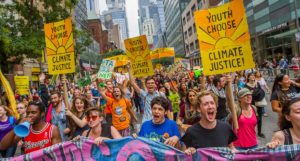Greenpeace leaders, change agents, colleagues, and instigators —
When we wrote to you at the end of our first year, “people power” was little more than a buzzword. A few years later, thanks to you, people power is fundamental to how we work and how we win. Here’s our take on how Greenpeace has grown over the past year.
But we’re only as strong as our ability to learn and evolve, so we’ve also included our reflections on how Greenpeace can challenge itself to stay sharp in 2016.
A special thank you to those who welcomed us into your teams and offices to help make much of this work possible – in particular, 12 national and regional offices and all six global campaign baskets. You invited us to take risks with you, learn together, and explore new paths.
Here’s to even more in 2016.
– Michael Silberman for the MobLab (Tracy Frauzel, Emily Hunter, Ben Simon)
Deploying modern engagement strategies and tactics
2015 showcased dramatic, people-powered victories – from the forests of Mahan to the farms of Dolores; from Seattle to the Great Barrier Reef.
One key ingredient: you consistently showed that mobilisation and engagement talent are essential roles on project teams and in campaign meetings.
Together we began asking how to use data to make better decisions in our campaigns – setting new metrics for how we measure people power (see Beyond Vanity Metrics) and, in several places, transforming how we track progress so staff may more rapidly evolve campaign strategy.
Greenpeacers also demonstrated a strong commitment to learning. You joined six global Peer Sessions in record numbers, led dozens of sessions with allies at Open Campaigns Camp (July) and Mobiles x Mobilisation Camp (Oct), and over 1,000 of you engaged outside experts and new ideas alongside movement partners via MobLab Live.
Next: Greenpeace has built a powerful and trusted reputation through decades of bold, cutting-edge campaigning. The risks we take in engagement and building people power usually pay off. How can we establish and reward a culture of innovation through ongoing experimentation and learning in order to achieve even greater impact? Can we create more opportunities to launch minimum viable campaigns that give us opportunities for greater testing, measurement, and learning?

Proving new ways of thinking
Greenpeace teams and offices worldwide are more engagement-driven and audience-centric than ever.
Half a dozen offices elevated mobilisation and engagement positions into senior leadership roles in 2015 – with new titles like Deputy Programme Director, Chief Engagement Officer, and Director of Participation.
You’re increasingly putting people at the centre of campaigns – researching the problem, co-creating ideas, and getting feedback on campaigns before they go out the door. (Check out the hackathon Greenpeace Netherlands organised with designers and developers to solve the problem of tracking trawlers on the high seas.)
You’ve made alliance- and movement-building a priority – from showing up to support social movements (even when it wasn’t essential for short-term campaign objectives) to investing in opportunities to build longer term power. Greenpeace’s highest priority battles—and victories—of 2015 were won together with partners.
Here’s a Mobilisation Cookbook we compiled with many of the practices you’ve incorporated into everyday campaigning.
Next: People power is now a common consideration and shared priority for every type of campaign, office, or long-term planning we do at Greenpeace. The next step is to ensure that engagement strategies are integrated into planning processes from the start, rather than tacked on at the end. That’s how we achieve truly transformational people-powered campaigns that win at larger scales.

Getting more creative – and enabling others to be innovative
You’re increasingly showing what it means to activate the full potential of Greenpeace staff and colleagues so that, in turn, we can enable the full potential of millions of individuals and change agents around the world.
The Creative Facilitation network at Greenpeace now includes over 250 global staff and volunteers; participants said they used new creative collaboration methods to engage and co-create ideas with allies, students, donors, volunteers, and other staff to develop new campaign strategies, solve management issues, and surface ideas for fundraising, NVDA, and volunteer activities – and to deliver the “big listening” staff consultation for the Long Term Global Framework.
You’ve taken the participant-led meeting model global, building participatory meeting methods into more than six large, international meetings. We introduced the model via the Digital Mobilisation Skillshares (2012-2014), but you made it a new standard for Greenpeace over the past year.
Next: You’ve explored the potential of and practiced the skills for creative ideation. The next step is to regularly, consistently apply these new tools to the many challenges we face internally and externally.
Being more open
You’re inviting ever more people into different phases of campaign work, and integrating open campaigning principles across the organisation.
You’re welcoming more ideas from more people through new forms of listening and by seeking input beyond staff. The Detox Outdoor project launched using “open” campaigning and human-centered design principles, co-creating a global week of action with the outdoor community. And the Long Term Global Framework planning incorporated an unprecedented number of stakeholder interviews, surveys and focus groups. MobLab was proud to advise and inform the design of both.
Together we launched a community of practice and explored the key elements of open campaigns at the first Open Campaigns Camp. And the Mass NVDA working group is designing ways for Greenpeace to engage more people and build movement power by leading and participating in actions in more open, collaborative, and inclusive ways.
Next: We’re beginning to discover new ways to engage more people more deeply in campaigns, but we still need to develop new muscles for inviting meaningful input and expertise from supporters – as well as for spotting opportunities outside of our usual campaign-based focus. How can we further embrace and benefit from the “wisdom of the crowd” — open sourcing our mission to inspire and enable more people to campaign for a green and peaceful planet?
Looking back, looking ahead
- MobLab’s 2016 Plans: Here’s what we’ll be focusing on this year.
- Top Stories from 2015 — What you read and shared the most: How transformations in people power, open campaigns, mobile and security are changing global campaigning.
- MobLab’s 2015: a detailed rundown of our projects and progress from last year
Categories:
MobLab updates
